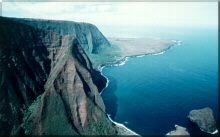

 |
     |
However, by the time King Kamehameha I died in 1819, Hawaii's socioeconomic system was already undergoing dramatic changes. Many of the ancient customs of the traditional "kapu" system were overthrown, and the burgeoning whaling industry and the missionary movement were beginning to alter the island's former way of life.
Hawaii slowly became populated by mainlanders trying to make money off of the islands' natural riches. And as in many parts of the world, the indigenous traditions of the Hawaiian islands ultimately gave way to sometimes violent pressures from missionaries, to be replaced by Catholicism and Christian morality. After the sugar industry came to Maui in 1849, the island changed even further. Laborers from all over the world were brought in to work the sugar fields--bringing with them foreign plants, animals, languages, and customs.
By the late 19th century, the United States was actively involved in shaping the islands' politics. Although the majority of Hawaiians opposed annexation, President McKinley signed an annexation agreement on July 7, 1898. Hawaii was granted full statehood on August 21, 1959.
In winter (Dec. thru Mar.), the nights may drop to the lower 60s and you're more likely to experience a rainy day. No Rain - No Rainbows! Spring, summer and fall are all very similar with warm days (up to 85¡F) cooled by the trade winds and pleasant evenings in the mid to lower 70s.
Although contemporary culture in Hawaii is similar to that of the rest of the U.S., Hawaiians strive to preserve cultural traditions. Language and hula classes are common, and traditional arts and crafts thrive. The social tradition of giving flower necklaces, or leis, illuminates the richness of the Hawaiian culture. Different leis have different meanings. Tourists are given leis of plumeria, while a bride might wear a lei of pikake. There are special leis for hellos and good-byes, and each island has its own particular lei.
Location
The Hawaiian Islands are located just south of the Tropic of Cancer in the Pacific Ocean, 2,400 miles southwest of California. Anchored in the center of the 8 major islands, Moloka'i is 25 miles (40km) southeast of Oahu, and a 25-minute flight from Maui. From the eastern end of the island, it's only 8 miles (13km) across the Pailolo Channel to Maui.
Geology
The Hawaiian islands were all formed by volcanic activity on the ocean floor of the Pacific. Each island is essentially a mountainous volcano or group of volcanoes that has risen above the surface of the ocean and expelled lava to create land mass.
History
Before annexation to the United States, Hawaii was once an independent kingdom. Each island was a separate domain until 1795, when the first King Kamehameha united all of Hawaii. The charismatic Kamehameha and a dynasty of his progeny ruled the islands for the next century.
Weather
The weather is usually good year round with temperatures averaging about 75¡F and rarely going 6 or 7 degrees above or below.
When To Go
When can you get away? Actually, anytime is a great time to visit. The weather is usually good year round with temperatures averaging about 75¡F and rarely going 6 or 7 degrees above or below.
The People
Moloka'i's population, numbering less than 7,000, includes the highest percentage of people of native Hawaiian ancestry of any of the major Hawaiian islands. Because of their friendliness to visitors, Moloka'i is also known as "the Friendly Isle."
Cuisine
Hawaii's sizable Asian influence is evidenced by much of the islands' cuisine. A typical "mixed plate" for lunch comes with rice and macaroni salad, as well as your choice of an Asian dish such as chicken teriyaki (Japanese), beef with oyster sauce (Chinese), or kalua pig (Hawaiian). Kalua pig, a favorite of luaus, is a suckling pig slow-cooked in an underground oven. Dried salted fish is also a favorite, as is poi, a stew made from the taro plant. Indigenous fruits such as star fruit and breadfruit are used in many traditional recipes.
Calendar of Events
Special Events on Moloka'i include a celebration of the birth of hula which occurred here, drag races featuring some famous Moloka'i mules and outrigger canoe races across the 26 mile channel to Waikiki on Oahu.
Annual Ka Moloka'i Makahiki (Ancient Hawaiian Games)
Kaunakakai Town Baseball Park & Mitchell Pauole Community Center. In addition to the ancient Hawaiian sports competition, there will be craft and food booths and entertainment featuring the Native Hawaiian Band.
Prince Kuhio Celebration Kiowea Park.
6th Annual 10k Run & Health Fair Sponsored by Moloka'i General Hospital.
Annual Moloka'i Ka Hula Piko Festival. A celebration of the birth of hula. Papohaku Beach Park.
Starbuck's Kayak Challenge. Ocean kayak race from Kepuhi Beach, Moloka'i across the 26 mile channel to Oahu.
4th Annual Maunaloa Cowhorse Classic See cowboys and their best cattle horses compete at Moloka'i Ranch.
Annual Ho'olaulea O Ke Kai Seafest & Ocean Activities - Kaunakakai Wharf.
Aloha Festivals Parade & Mule Drag Moloka'i style parade & ho'olaulea followed by "Drag Races" on Kaunakakai's main street. Featuring some of the famous Moloka'i mules.
Na Wahine O Ke Kai Woman's outrigger canoe championship - Moloka'i to Oahu.
Moloka'i Hoe Men's Moloka'i to Oahu outrigger canoe championship.
5th Annual Molokai Ranch Rodeo & Stew Cookoff. Moloka'i Ranch. Contact The Outfitters Center 808.552.2791 or 800.254.8871